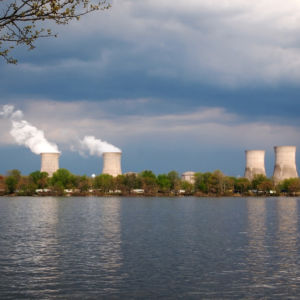The fight to save the Three Mile Island nuclear power plants is reaching its final stages. Last week, Exelon, the utility company which owns and operates the plant, announced that Pennsylvania legislators have until June to approve subsidies to save it. Without state help, Three Mile Island and Beaver Valley, a dual-reactor plant outside of Pittsburgh, are scheduled to prematurely close, taking with it thousands of Pennsylvania-based jobs and shuttering two of fewer than 100 remaining American reactors. Coming even as Congress begins to debate the Green New Deal, the situation shows the difficult position in which the nuclear power industry finds itself.
Exelon CEO Chris Crane told analysts last week that Three Mile Island’s remaining operating reactor would be forced to close if Pennsylvania legislators were unable to approve a subsidies package by June. That is when the company needs to order a new core prior to a scheduled refueling. In order for TMI to continue to operate beyond September, the plant would need to be refueled during a standard refueling outage this fall. However, the fuel must be ordered months in advance so that it can be fabricated and delivered to the site to prepare for a refueling outage. If legislation is not enacted, Three Mile Island will begin decommissioning in September in accordance with NRC regulations.
Pennsylvania’s Nuclear Energy Caucus, which had been holding hearings about the benefits of nuclear power for much of last year, announced upcoming legislation that would include nuclear power in the state’s Alternative Energy Portfolio Standards. In effect, this would require consumers to pay extra for the plants’ no-carbon generation. Five nuclear power plants are operating in Pennsylvania, responsible for about 40 percent of the state’s power.
Three Mile Island is the second nuclear power plant slated for closure.
Supporters of nuclear power have been struggling to find a way to support existing reactors. In many areas, nuclear is excluded from state-level renewable portfolio standards, despite its no-carbon status. Meanwhile, it is losing out to natural gas in terms of pricing and flexibility. Nuclear reactors, which are fueled once every few years, are able to consistently provide power regardless of weather or commodities price fluctuation. Today’s power generation market rewards generators that are able to switch on quickly to meet short-term periods of high demand.
Changes to Pennsylvania’s Alternative Energy Portfolio Standards would require electricity distributors and suppliers to ensure that a certain portion of their power purchases come from nuclear. Any increases in wholesale power prices would be passed on to consumers. That idea has been a difficult sell for both free-market Republicans and the state’s booming fracking industry.
That may hurt Pennsylvania consumers in the long run.
“Allowing Pennsylvania’s nuclear power plants to succumb to failed energy market policies will cost Pennsylvanians an estimated $4.6 billion annually,” wrote state Rep. Thomas Mehaffe in a recent memo.
For Mehaffe, and other nuclear allies, clean energy standards that fail to reward reliability are setting a bad precedent. One of nuclear power’s strengths is that it is a scalable, zero-carbon generation source. Unlike solar and wind generation, it can produce reliable power which does not fluctuate based on the weather. Geothermal energy, which draws off of the heat of the earth’s core, and hydropower, from dams, are similar in this regard, but are reliant on geology. Unfortunately, recent pro-green energy efforts–including the much-hyped Green New Deal–are pitting nuclear power against solar and wind, rather than considering them complementary power sources.
“One of my deepest concerns with a resolution such as the Green New Deal, well-intentioned as it may be, is that the solution space is so radical the outcome will likely be that two perfectly compatible and necessary carbon-free energy resources (nuclear power and renewable energy) end up being pitted against each other in a survival-of-the-politically-fittest energy resources death match,” David Gattie, an associate professor of environmental engineering at the University of Georgia, tells InsideSources. Gattie, who has studied both solar and nuclear power, believes that America’s power mix requires both.
“It’s unnecessary because we need both and both have benefits. But only nuclear power provides low-carbon, reliability and national security benefits.”
The language of the newly-introduced Green New Deal offers a sliver of hope to nuclear energy proponents, since it calls for a transition to a zero-carbon, rather than a renewable energy standard. the tone of the debate, though, worries those who believe that nuclear has an important role to play in America’s generation mix.
“While some may argue that nuclear is accommodated by the inclusion of the phrase “zero-emission sources”, that argument doesn’t convince me at all,” Gattie continued. “In fact, in the roll-out, Rep. Ocasio-Cortez explicitly stated that the objective is 100% renewable energy.”
Focusing on renewable power without looking at reliability has so far left nuclear energy behind. The announcements about Three Mile Island and Beaver Valley shows that the window for preserving America’s nuclear generation is rapidly closing. Even in a political climate pushing for zero-carbon generation, nuclear is being left out in the cold.

